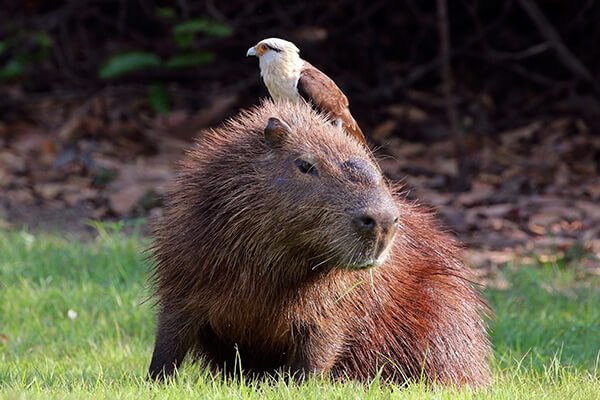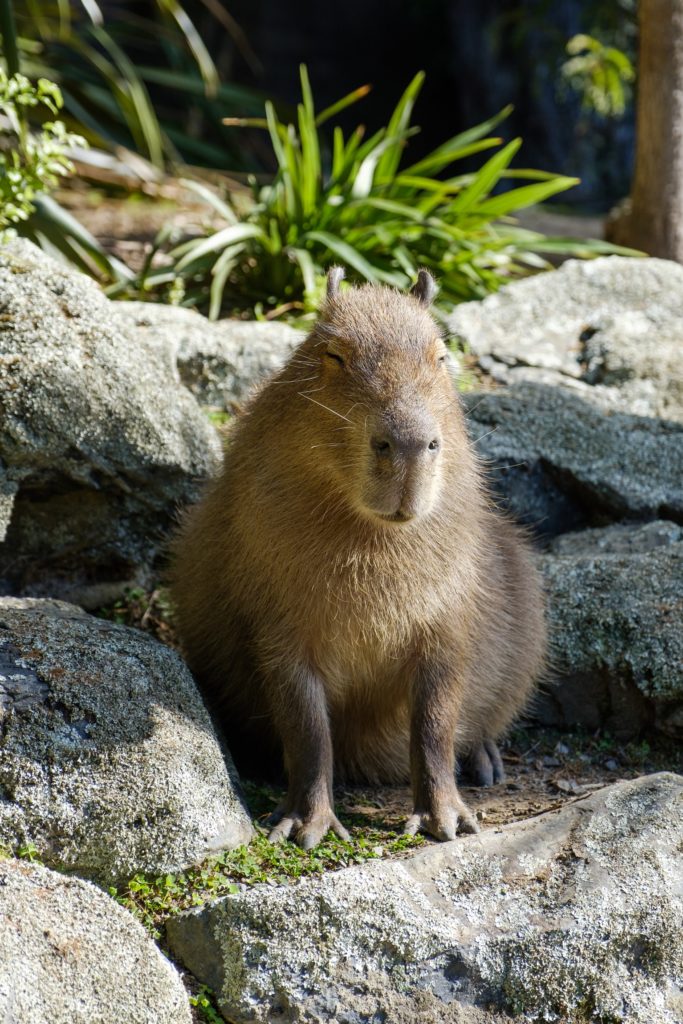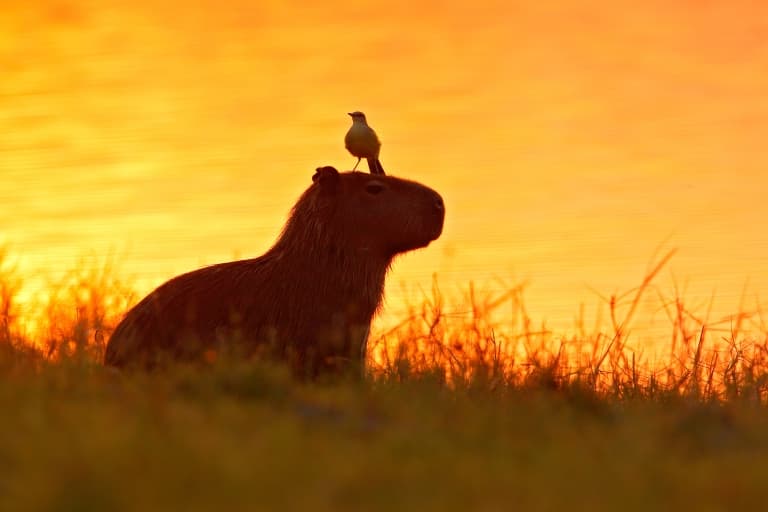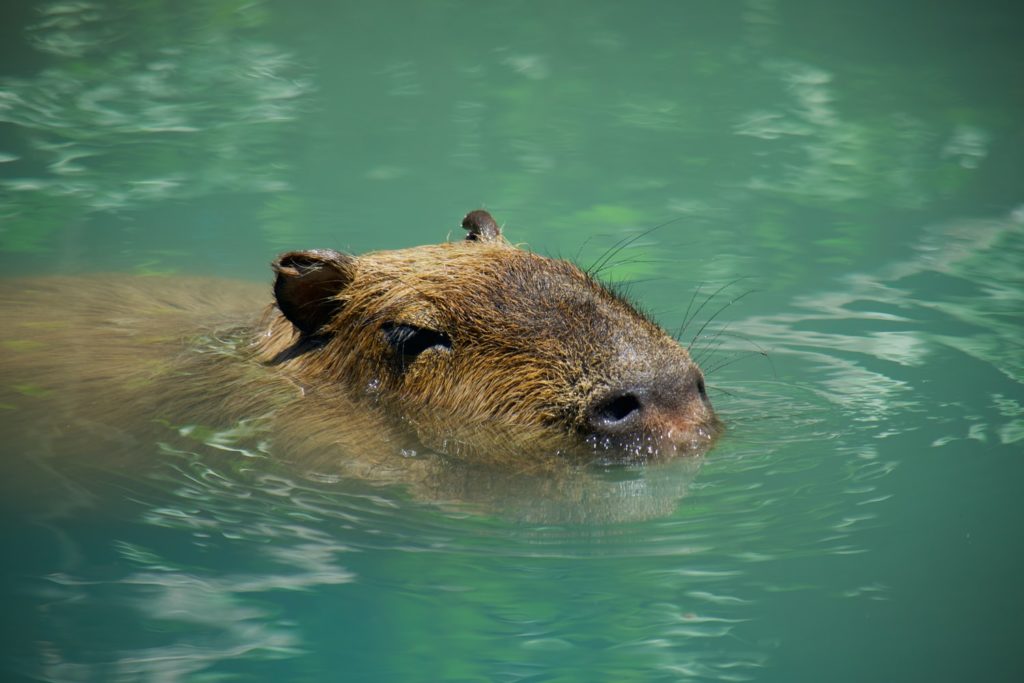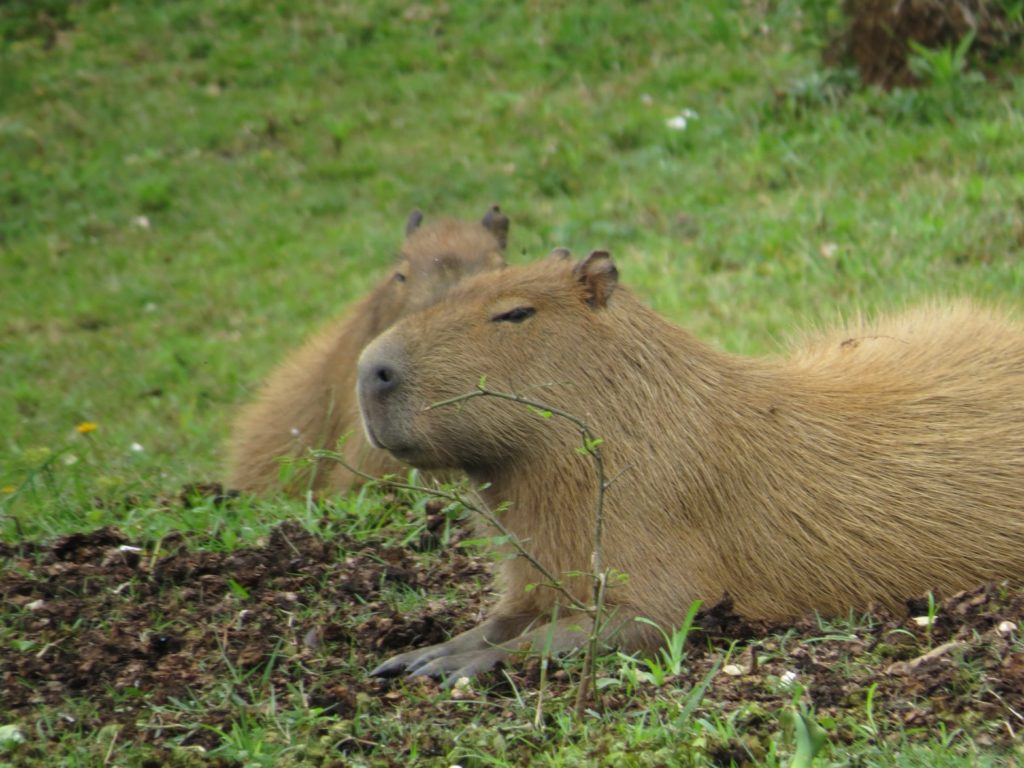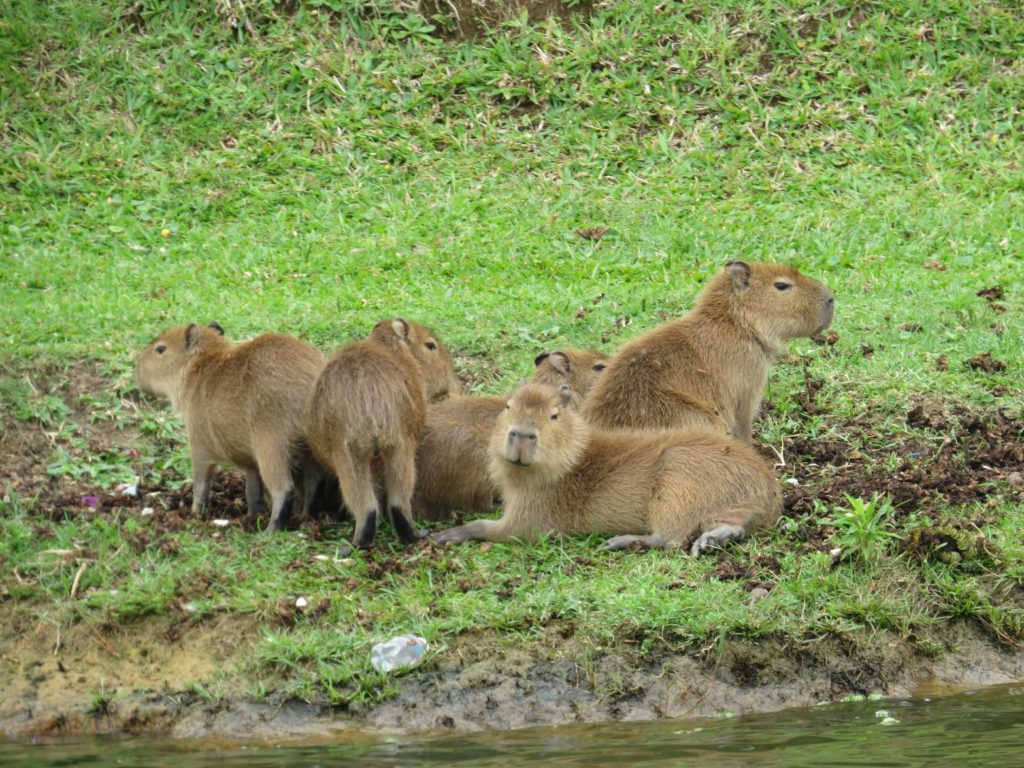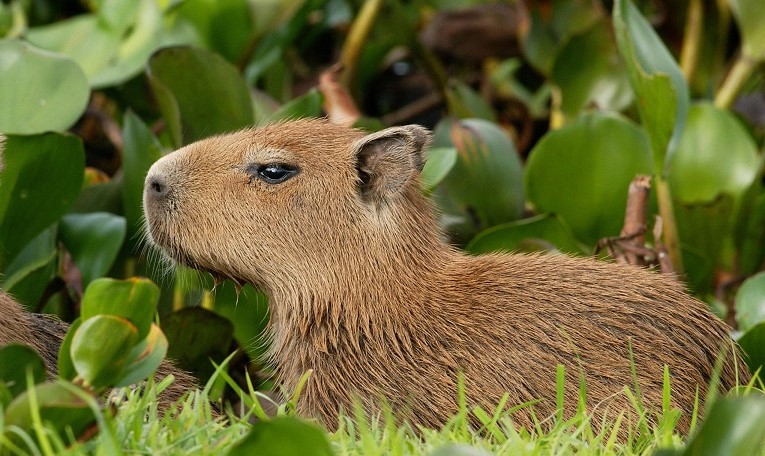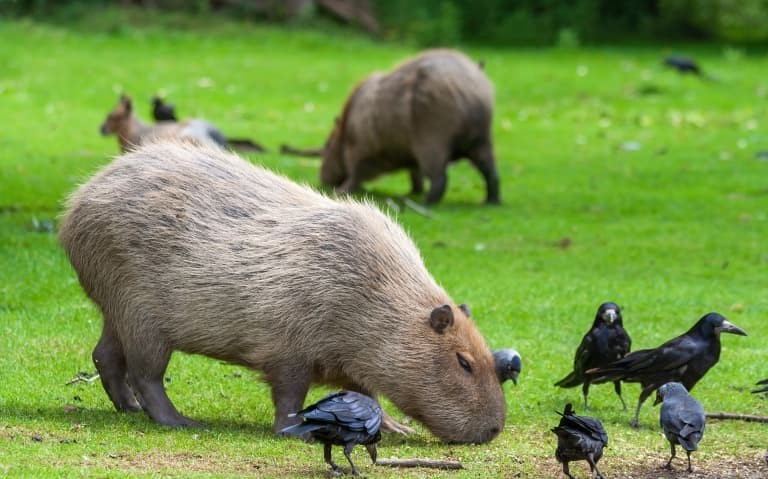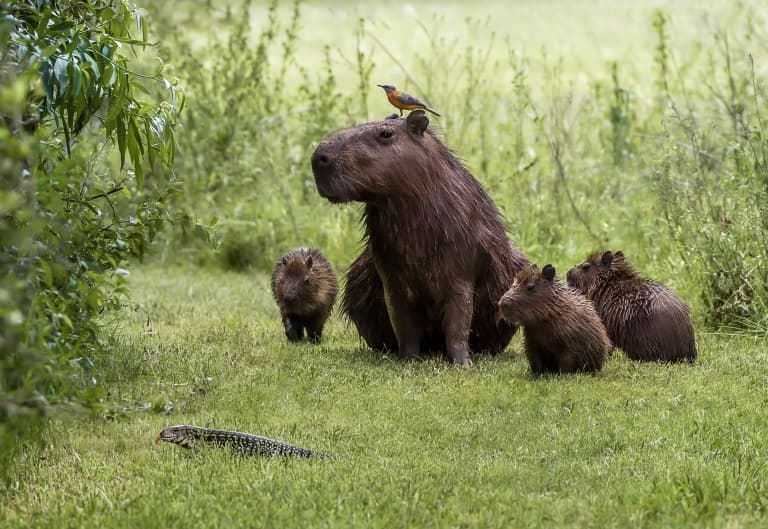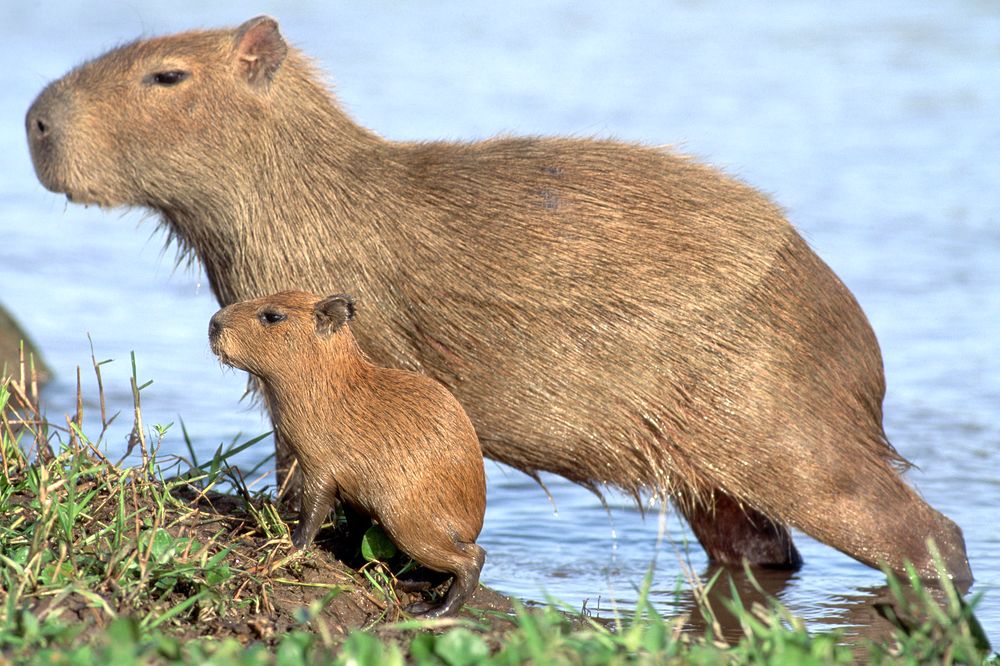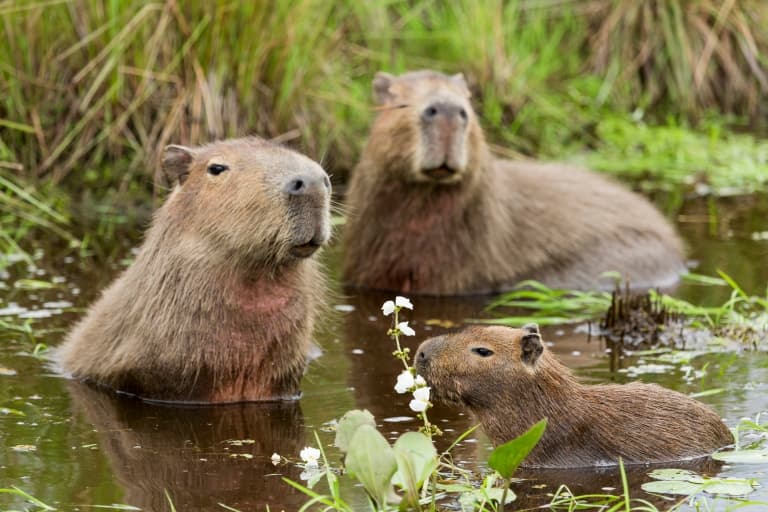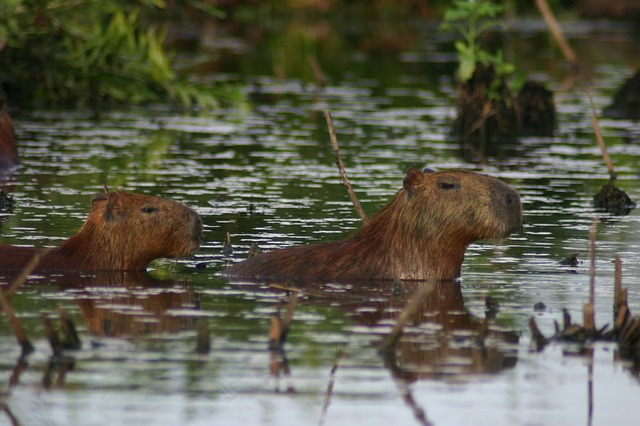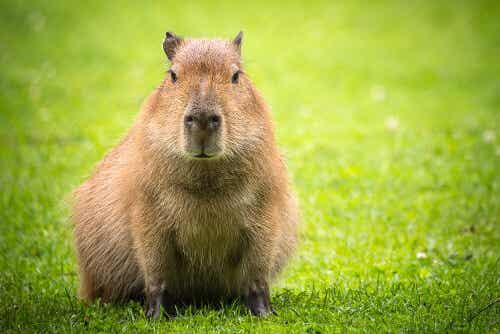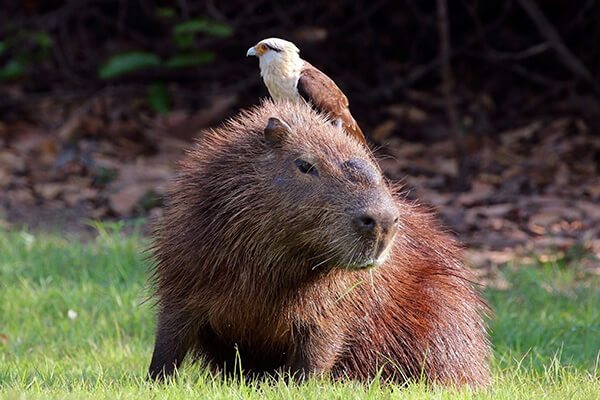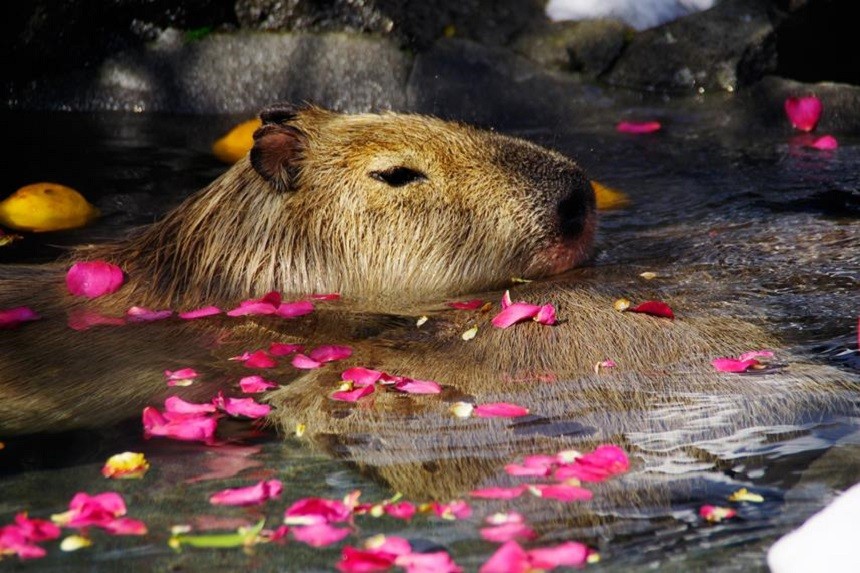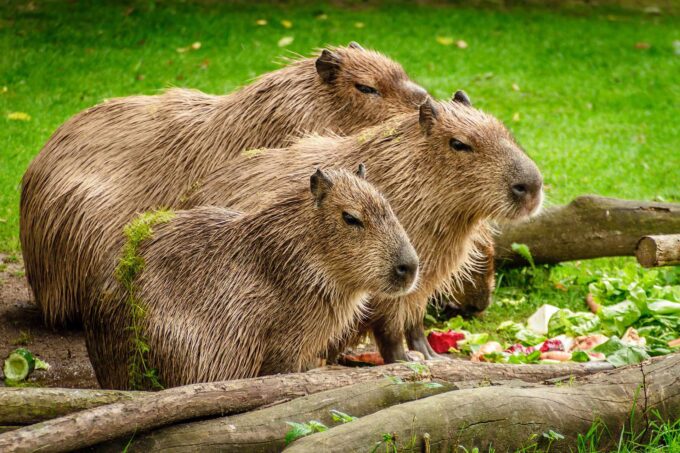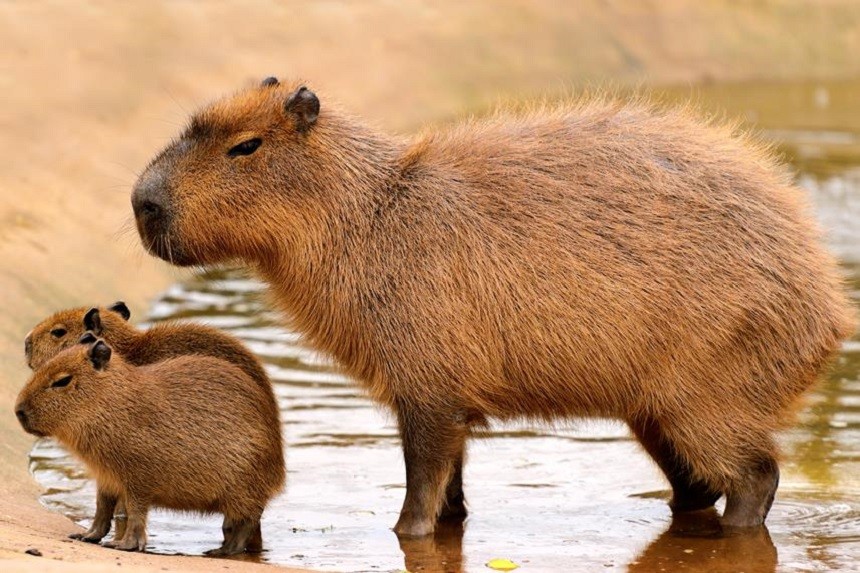
the largest rodent
Capybara (Hydrochoerus hydrochaeris) is the largest rodent in the world, and it feels great both on land and in water. This is what water areas are for a perfect hiding place from predators. Despite that, capybaras they need an exceptionally large territory to live, they are often bred in South America as pets. There are also known cases when acted as a guide dog.
First mention
The first mentions of this unusual rodent come from 1766 – we can find them in the writings of Linnaeus. It was this Swedish naturalist and doctor who mistakenly recognized him as a pig.
Classification
South America Rodents Mammals Animals
Class: mammals (Mammalia)
Order: Rodents (Rodentia)
Family: Maraceae (Caviidae)
Genus: Hydrochoerus
Species: Capybara (Hydrochoerus Hydrochaeris)
Capybaras (Hydrochoerus hydrochaeris).
Occurrence and natural environment
Capybara is an animal characteristic of South America. You can meet her in Panama, Colombia, Venezuela, Peru, Brazil, Paraguay, to northern Argentina and Uruguay. This animal adapts quite easily to various conditions environmental. For this reason, it inhabits both marshy areas as well located near rivers and lakes, as well as grassy and even wet areas tropical forests. Capybaras make their place of stay dependent on Seasons. In the dry season, they stay close to water bodies, while in wet, they move away from them. Capybaras also like to inhabit areas where cattle are fed. It follows this is due to the fact that these areas are not only rich in water and food, but also very safe. Any predators that may threaten animals are for chased away by man. Insects removed by monkeys.
Characteristics
Capybara is the largest living rodent. This animal characterizes it stocky build and a large head with a square-ended snout. It has short but strong legs, and the feet have long claws, allowing capybara to move easily over muddy terrain. Back the paws of the capybara are slightly longer than the front legs. This large rodent also has the tail; however, it is small. The eyes, ears, and nose of a capybara are located at the top of her head. Despite this the animal has perfectly developed senses of sight, hearing, and smell. Thanks, with such a location of these organs, the capybara does not lose its senses even in water. When it feels threatened, it escapes to the water, exposing it above it the surface is only the top of the head, which allows it to observe the predator. Capybaras are covered with short, coarse fur, the color of which varies from reddish brown on top of body to yellowish brown on underside. As with other rodents, capybara incisors grow throughout their lives, which causes them the need to constantly wipe them off.
Diet
Capybara is an herbivorous animal. She is in her food choices very picky and foraging – especially in the humid season when vegetation there is more. As much as 75% of her diet is then three to six types of plants. During the dry season, her diet becomes more varied. The food of capybara also depends on the season – plants eaten in summer, in winter they lose their nutritional properties completely, which is why the animal has to introduce a different food into your diet.
Threats
The natural enemies of capybaras are anacondas, jaguars, pumas, ocelots, and eagles Cayman Islands. While capybaras are not endangered animals, in some their population decreased significantly. This is mainly due to the fact that they were slaughtered for the flesh and skins. Today they live in harmony with people, however, in some areas where their natural environment has remained significantly limited – they enter farmland. For this reason, they do seen as pests.
Lifestyle
Capybaras are great swimmers, and for this reason they run amphibiously lifestyle. These animals usually spend the mornings resting, and the hottest moment of the day are wallowing in mud or shallow waters. Grazing begins in the afternoon and usually lasts until late night hours. Capybaras eat very slowly, which is why it takes a long time for them to forage. The enemies of capybaras in South America are jaguars.
Social life
Capybaras are very social animals – they live in groups of about 20 individual that. The size of the groups depends on the season. They are in the dry season more numerous than in the wet, where the herd’s population decreases on average to 6-7 capybara. Each of these groups consists of the dominant male, female, and theirs young. Only about 10% of the total capybara population lives a solitary life and they are always males. Capybaras communicate with each other through a range of different sounds – like for now, researchers have recognized five of them, and also by the smell that comes from the glands around their behind.
Reproduction and development
The capybara breeding season usually begins in April or May, though it depends on the region inhabited. The males then compete with each other for the favors of females, and of course the strongest of female partners. Pregnancy in capybaras lasts about 5 months, and it comes into the world from one to eight young, but usually four. Childbirth takes place on land. The female joins the herd after just a few hours, and the young – as soon as may start to move. It is not an exceptionally long period – small after a week they are already eating grass, but nevertheless their mother feeds them for about 16 weeks. Capybaras can live from 8 to 10 years, but the average life expectancy is 4 years, mostly due to attacks by predators.
Name
Capybara in Guarani (South American Indians) is Kapiÿva. The nomenclature of capybara is remarkably diverse in their areas of occurrence (South America). The following names can be found: capibara, capivara, capiguara, carpincho, dia-baj, capybara, julo, jesús, chigüiro, tanacoa, pataseca, bocaeburro, culopando, ponche, cabiari, sancho, poncho, carpincho, capiguara, ronsoco, samanai, chigüire, capigua, capiba, kiato, chindó, chindoco, cochon d’eau (French for water pig), cabiai, kapoewa, water pig, Waterzwijn.
Body size
There is a slight sexual dimorphism in capybaras – females are slightly heavier than the males.
Body length: 107 to 134 centimeters
Height at the withers: 50 to 64 centimeters
Weight: 35 to 66 kilograms (record 91 kg)
Capybara as food
Not only were they, but in some regions they are still being killed for meat and skins (they have been eaten here and there even in fasting, since the Pope recognized them as fish in the 16th century!), Or for trespassing into farmland.
***INTERESTING FACTS***
- Capybaras do not mind being alone, but they also live-in groups of up to 40 individuals.
- They can live 8-10 years in the wild and about 12 years in captivity.
- It is about the size of a Labrador Retriever.
- They are able to run almost as fast as horses.
- Capybaras are closely related to guinea pigs and to chinchillas.
- Capybaras are the favorite food of Anaconda snakes.
- Their Teeth Never Stop Growing
- Capybaras can be found near bodies of water because of their semi-aquatic lifestyle. Living by the water is still the perfect place to make a nest – allowing them to quickly withdraw and get away from predators such as anacondas, wild cats and even eagles.
- The capybara is covered with a sparse brownish fur and has no tail.
- They are able to reach speeds of up to 35 kilometers per hour. It is like an amazingly fast man running.
- Typically, a group of capybaras has a ratio of one male to two females. This ratio is preserved because minor males in the periphery of the group are more susceptible to predators.
- Capybaras are kept as pets; there is even known a case in which this large rodent acted as a guide dog.
- Capybaras are vegetarians
- They are a favorite food for jaguars, eagles, anaconda snakes, and many other animals.
- The heaviest female found weighed 91 kilograms, and the male 73.5 kilogram.
- They Have A Unique Vocal Repertoire . Capybaras are rather vocal animals. They like to express themselves by purring, barking, cackling, whistling, squealing, whining, grunting and even teeth-chattering—depending on what they are trying to communicate. Not only are there harmonic differences among social groups, but each sound a Capybara makes bears a significant meaning. 5 Alerts from group members can be environmental cues, including as danger from predators and isolation of their young.
- Capybaras got their name from the Tupi language from Brazil. Their literal translation means “one who eats slender leaves”.
- Capybaras, like guinea pigs, do not have the ability to synthesize vitamin C. This means that captive animals must ingest her supplements – otherwise they risk scurvy.
- When they are underwater, capybaras are able to hold their breath on five minutes.
- Capybaras are physically well-adapted to a semi-aquatic lifestyle. Their webbed feet help them maneuver in water and traverse soft, muddy ground. Their facial features are located towards the top of their large heads, allowing them to see and breathe while swimming.
- Capybaras can press their ears against their heads to keep water out. Once they exit the water, their thin coat of coarse hair dries quickly.
- Capybaras are currently considered by the IUCN Red List to be of least concern of becoming extinct,
- Capybaras live in Central and South America. They can also be found in many zoos around the world.
- They like to express themselves by purring, whistling, squeaking, groaning and even biting their teeth, depending on what they are trying to convey.
- The breeding season of capybaras varies throughout the year depending on the habitat in which they live.
- Since they are semi-aquatic, they love to hang out in the water and are great swimmers. Capybaras are especially fond of wetlands and swamps.
- Like rabbits, their long teeth are perfectly suited to cutting food.
- Capybaras have a special digestive adaptation that allows them to absorb enough nutrients from their diet. A large fermentation chamber in their intestines stores and breaks up fibrous materials, mixing them with bacteria, enzymes, and gases to aid digestion.
- Until 1969, they were also hunted in Brazil for their skin. Today, it is prohibited to hunt capybaras in Brazil, while in Venezuela its hunting is regulated. Locals still use to hunt them for their skin and meat.
- Because the hair covering a capybara is sparse, its skin can easily get sunburn from prolonged exposure to the sun.
- Capybaras can dive and stay underwater for up to 5 minutes, often falling asleep in the water while keeping their nose on the surface of the water. Diving along rivers, mangroves, and swamps helps keep them cool. In South America, it is hot to repair.
- Being the dominant male has several advantages. Not only does it enjoy a position in the center of the group, safer than predators, but also mates with all the females in the group.
- The capybara can hide underwater from predators, and the jaguar is the animal’s main natural predator. If a jaguar comes close to the water, the capybara moves underwater, where it can hold its breath for up to 5 minutes. The eyes and nostrils of a capybara are close to the top of its head, allowing it to approach the water for a while and breathe without being easily noticed.
- Although their population is believed to be stable, in some area’s capybaras are seriously threatened by humans who hunt them for their skin.
- They eat a diet of aquatic plants, grasses, bark, tubers, and sugarcane. And while they are able to eat their greens in just a short week of birth, they drink milk for the first 16 weeks of their lives.
- They feed on grasses and aquatic plants, eating 3-3.5 kg per day.
- They weigh an average of 50 kg.
- Baby capybaras are not effective swimmers at first, so they stay on land, hiding under brushy cover.
- Females usually have one litter – four to five young per year.
- To distinguish males from females, it is sufficient to observe the olfactory gland above the mouth. Male capybaras have a whitish and sticky substance in this area. It is a concentrate they use to mark their dominance over the rest of the herd.
- They Can Even Sleep in Water
- Capybaras live in a hierarchical system. To raise their position in the group, the male members of the herd engage in constant fights with each other.
- Males are also very promiscuous as they can have multiple partners throughout their lives. Although the number of “companions” will always be proportional to the ability to win battles with comrades.
- These animals can stay under water for up to five minutes without having to come to the surface to breathe. Thanks to this ability, in combination with their swimming skills, they often use the flow of rivers and the depths of some backwaters or lakes as escape routes from predators.
- They love spending the hottest portions of the day in water or wallowing in the shade, capybaras graze in the morning and evening when it is cooler.


